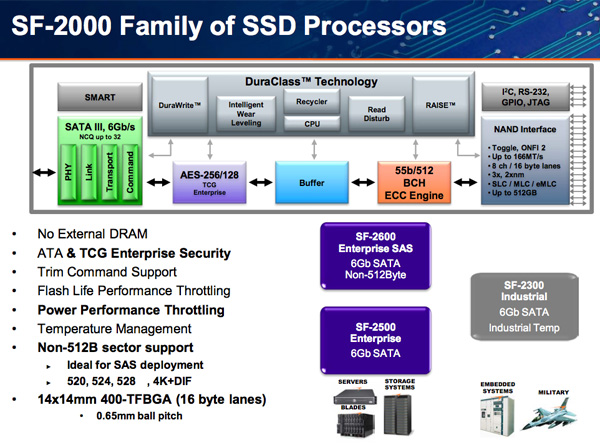SandForce Announces Next-Gen SSDs, SF-2000 Capable of 500MB/s and 60K IOPS
by Anand Lal Shimpi on October 7, 2010 9:30 AM ESTSecurity: AES-256 and Double Encryption
The SF-1200/1500 controllers have a real time AES-128 encryption engine. Set a BIOS password and the drive should be locked unless you supply that password once again (note I haven’t actually tried this). The SF-2000 implements an AES-256 engine and supports double encryption. The former enables stronger encryption, while the latter allows you to set a different encryption key for multiple address ranges on the drive.

Enhanced ECC
As NAND densities go up, so will error rates and in response SandForce boosted the error correction engine on its controller. The SF-2000 error checks and corrects at a 512-byte granularity with a 55-bit BCH, up from 24-bits per 512-bytes.
The Family
SandForce is announcing three parts today: the SF-2300, SF-2500 and SF-2600. All three controllers have the same performance specs but differ in features.
The SF-2500 is the base enterprise drive. For industrial use there’s the SF-2300 that can operate at more ridiculous temperatures. The SF-2600 ships with the external SAS bridge and a special firmware revision to enable support for non-512B sectors.

Many enterprise storage systems use larger-than-512B sectors to store error correction information among other things. These sizes can be awkward like 520 bytes, 524 bytes, 528 bytes or even a 4K sector with an additional data integrity field. Currently the SF-1200/1500 controllers support these non-standard sector sizes, but you run into performance issues since writes aren’t aligned to how the drive is organized internally. With the SF-2600, there’s firmware support for any one of these sector types. The drive handles alignment issues in hardware, presumably without any performance overhead. SandForce indicated that you’d need to configure the drive for sector size in the firmware, meaning the adjustment isn’t dynamic.
Since this is a very particular type of enterprise SSD feature that’s usually seen in SAS devices, the SF-2600 is paired with a native SAS to SATA bridge. The controller is still SATA internally but the SF-2600 reference design will feature a SAS bridge on-board.
All of the enterprise SF-2000 controllers support TRIM. They also support performance throttling based on remaining program/erase cycles on the drive’s NAND (slow down the drive so the NAND lasts longer, as well as power based performance throttling (slow down the drive to reduce power consumption). SandForce hasn’t announced power specs for the SF-2000 drives, but given Intel’s drive power went up with the 3rd generation X25s I would expect something similar here.
The consumer member of the SF-2000 family will be announced sometime early next year. We will hopefully see a fairly high end version of the consumer part, missing only the enterprise specific features but retaining all of the performance.










84 Comments
View All Comments
tipoo - Thursday, October 7, 2010 - link
...Isn't going to stay relevant long, is it? Already up to 500MB/s SSD's, and SATA 3 isn't even mainstream yet. Its going to become a bottleneck soon, just like SATA II is for current SSD's.rundll - Thursday, October 7, 2010 - link
Well, OCZ introduced few days back a new data link interface HSDL to handle Sata bottlenecks. Let's see what this means in real life.aguilpa1 - Thursday, October 7, 2010 - link
Break out your piggy banks if this is the wavejonup - Thursday, October 7, 2010 - link
They are a private company. As Anand said, a success of the new controller might force them in an IPOiwodo - Thursday, October 7, 2010 - link
Can we plug 2 SATA 6Gbps into a Single 2.5" SSD? We manage to max out SATA 3.0 in one go, and it is SATA 3.0 not even widely available yet.I hope the there would be at least some minor improvement in their DuraWrite and other part of the controller. Otherwise it looks like an overclocked Sandforce with better NAND interface to me.
Firmware should be less of an issues, since it is similar to older chips, the firmware should be stable enough.
Cant wait......
rundll - Thursday, October 7, 2010 - link
"...Otherwise it looks like an overclocked Sandforce with better NAND interface to me"Did we read the same article?
nexox - Thursday, October 7, 2010 - link
Ehh, you know 12Gbit SATA/SAS is due out in 2012, right? That's about in time for Sandforce's 3rd gen controller.And just because they've managed to double their bandwidth with this generation doesn't mean they've still got another trick up their sleeves to double their bandwidth again for the rev after this one.
Iketh - Thursday, October 7, 2010 - link
we're not talking physical limitations of a head moving back and forth on a spinning disk.... doubling performance at the least is much more the norm in the realm of silicon, nothing remotely close to a "trick" about itsoftdrinkviking - Friday, October 8, 2010 - link
I hope we get light peak before that; I just like the idea of my data flashing around through my pc in bursts of light. It's all so very "future is now."iwodo - Saturday, October 9, 2010 - link
No Trick, DDR NAND @ 133Mbps x 8 Channel already gives you just over 1Gbps SSD.And that is with CURRENT tech, the best thing about SSD is that it is easily scalable. You could do 10 Channel like Intel, ( Expensive ), or 16 Channel for total bandwidth since you get 16 Chips on a SSD.
You could also speed up NAND with DDR tech or small node but higher clockspeed.
The only limitation is how fast the controller could work. Which we still have much headroom.